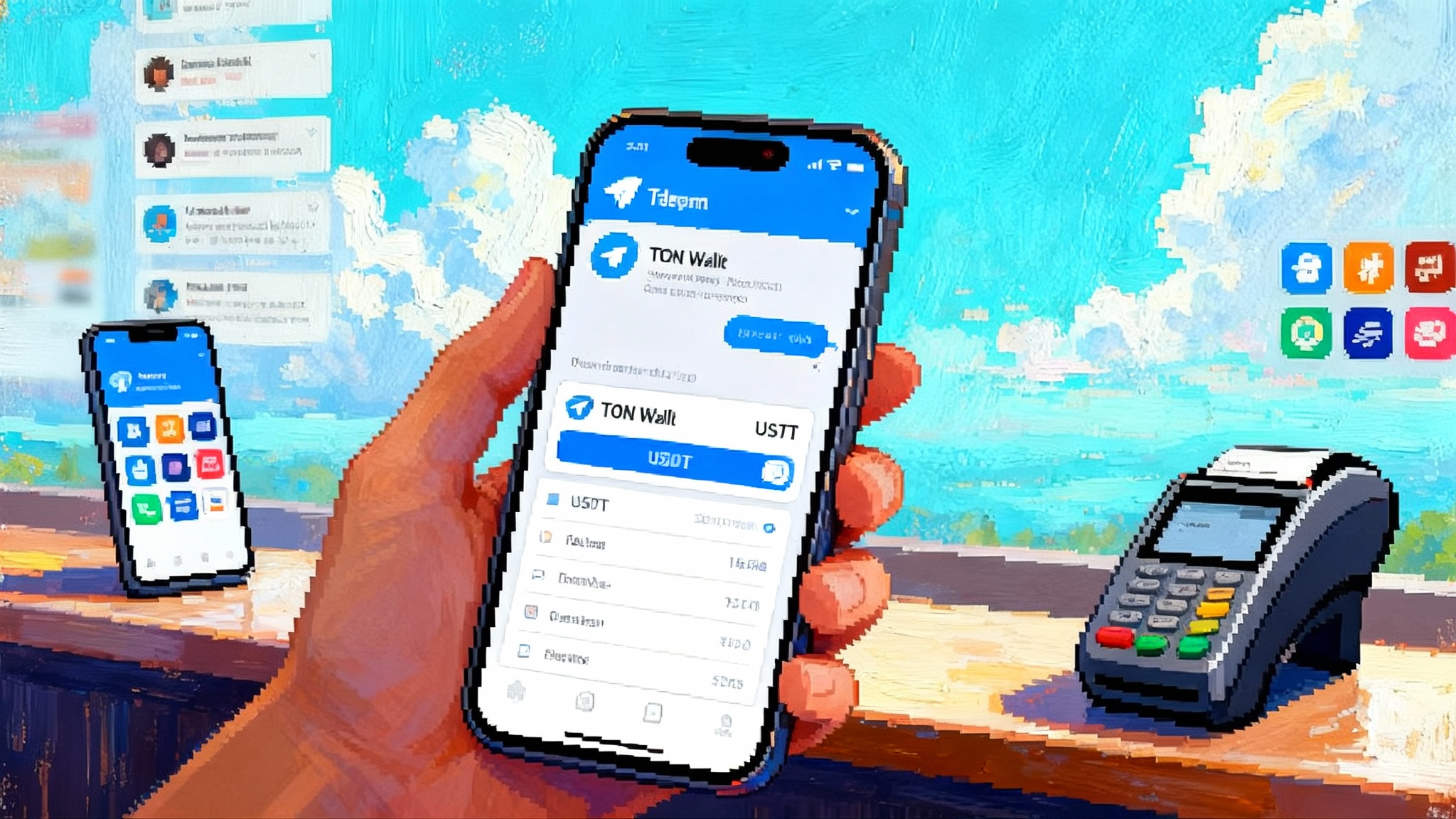USAT arrives: Tether’s $500B bid to remake U.S. stablecoins
Tether is rolling out USAT, a U.S.-regulated dollar token built with Anchorage Digital and Cantor Fitzgerald. Here is how this launch and a potential $500 billion valuation push could reorder stablecoins, DeFi, and real-world payments.

What just happened
Tether has unveiled a U.S.-regulated dollar stablecoin, styled USA₮ and commonly shortened to USAT, aimed at American businesses and institutions. The token is designed to comply with the new federal stablecoin framework and will be issued in partnership with Anchorage Digital as issuer and Cantor Fitzgerald as reserve custodian and preferred primary dealer. It will run on Tether’s Hadron tokenization stack and launch under a U.S. regulatory umbrella with a designated U.S. CEO. Tether laid out these details in its own announcement of USA₮ and leadership for its U.S. arm, which you can read in Tether unveils USA₮ and CEO.
The timing is notable. Reports indicate Tether is exploring a private raise that could value the company near $500 billion, an eye-popping figure for a firm whose flagship token already dominates global stablecoin liquidity. Reuters summarized those talks and noted Cantor Fitzgerald’s role advising on the deal. See the reported $500 billion valuation talks.
The compliance architecture: how USAT is expected to work
USAT is framed as a U.S.-regulated, dollar-backed token purpose built for businesses and institutions. From what Tether has disclosed, a practical model looks like this:
- Issuer of record: Anchorage Digital Bank, N.A., a federally regulated crypto bank. The charter and supervisory regime shape reserves, redemptions, and examinations.
- Reserve custody and market access: Cantor Fitzgerald as designated custodian and preferred primary dealer. Expect a conservative reserve mix focused on short-term U.S. Treasury bills, tri-party repo, and cash, plus robust intraday liquidity for redemptions.
- Legal framework: Compliance with the new U.S. stablecoin statute referenced by Tether as the GENIUS Act. In practice this implies 1:1 backing in permitted assets, clear redemption rights, frequent disclosures or attestations, and programmatic controls to meet sanctions and law enforcement requirements.
- Technology stack: Hadron by Tether as the tokenization layer, with whitelisting, blacklist and freeze capabilities, travel rule integration, and institutional identity gating.
- Governance: A U.S. management structure and committees able to work directly with U.S. regulators, auditors, and law enforcement.
Put together, this looks like a stablecoin that combines T-bill style reserves, bank-grade issuance, and capital-markets connectivity with on-chain programmability and compliance primitives that larger treasuries, banks, brokers, and fintechs require.
Why this pressures USDC and U.S. banks
Circle’s USDC became the default institutional stablecoin in the U.S. by aligning early with regulatory expectations and bank partners. USAT targets the same lane while importing Tether’s two global advantages: scale and distribution.
- Distribution advantage: Market makers, exchanges, and wallets worldwide already speak Tether. If USAT can be listed and bridged within the same operational workflows as USDT while satisfying U.S. compliance, switching costs fall and liquidity unifies across domestic and international venues. See how distribution is shaping competition in the stablecoin distribution war.
- Price and liquidity advantage: Tether’s depth helps stabilize pegs during stress and supports tight spreads. If USAT taps the same MM relationships and flow networks, USDC faces real competition on U.S. venues where it historically led.
- Bank pressure: Banks have wrestled with deposit outflows into money funds and stablecoins. A U.S.-regulated token backed by T-bills and repo, with a primary-dealer custodian, could accelerate that trend. Banks will need to answer with tokenized deposits, bank-issued stablecoins, or seamless on- and off-ramps into regulated tokens.
Circle still has meaningful strengths in compliance, payments integrations, and monthly reserve disclosures, but USAT could force price competition on fees and a faster cadence of programmable features.
The Treasury market angle: demand, plumbing, and yields
Stablecoins already matter to the U.S. rates complex. If USAT scales, three effects are likely:
-
More structural demand for bills and overnight repo. Tens of billions shifting into USAT reserves would add demand for 4 to 13 week bills and tri-party repo with top counterparties, potentially nudging front-end yields during risk-off. Compare with recent EU bank stablecoin plans.
-
Tighter settlement cycles. A primary dealer as custodian allows more active liquidity management, including bill rollovers, term repo, and same-day settlement windows, which support instant redemptions and peg stability.
-
Crowd-out dynamics. If corporates and fintechs can treat USAT as a cash equivalent with reliable intraday redemption and clean accounting, some flows may rotate from bank deposits and even money funds toward stablecoin rails that plug directly into DeFi and 24/7 markets.
Market structure and liquidity: who moves first
- U.S. exchanges: Expect the fastest uptake from venues that already list USDT offshore. If they can list USAT within U.S. compliance, they get deeper dollar liquidity without routing to non-U.S. entities.
- Prime brokers and market makers: A U.S.-regulated Tether rail lets MMs standardize operational playbooks across USDT and USAT, improving cross-venue arbitrage efficiency.
- OTC desks: Liquidity providers will prefer the token that settles fastest to their preferred fiat. If Cantor’s setup shortens fiat legs for large creations and redemptions, USAT becomes compelling for block trades.
The upshot is tighter spreads on U.S. venues and a narrower on-chain to off-chain basis during active trading windows, which improves user pricing across both retail apps and institutional platforms.
DeFi, exchanges, and payments apps: knock-on effects
- DeFi protocols: Permission-aware deployments will matter. Expect USAT pools where smart contracts enforce whitelists to meet U.S. compliance. That supports institutional DeFi use cases like on-chain repo, tokenized collateral, and programmable treasury operations. The vision mirrors the 24/7 money markets model.
- DEXs and routing: If USAT becomes the default dollar leg on U.S.-facing DEX front ends, routing could prefer USAT pairs for regulatory clarity. Liquidity may bifurcate for a while, with USDT dominant in emerging market flows and USAT gaining share in U.S.-regulated pathways, but aggregators will smooth the edges.
- Payments and merchants: The promise is instant settlement, programmable refunds, and lower acceptance costs. The key question is whether USAT can plug into compliance stacks and fraud tooling without increasing chargeback or AML risk.
- Cross-border B2B: A U.S.-regulated token with deep global distribution is powerful for supplier payments and treasury centralization. Multinationals can hold dollars natively in wallets, move them 24/7, and redeem to bank accounts in U.S. hours with minimal friction.
The $500B valuation push: why it matters
A capital raise that values Tether near $500 billion would signal that private markets view stablecoin rails as critical digital infrastructure with monetizable cash flows from reserves and services. With that capital base, Tether could:
- Invest aggressively in regulated U.S. operations, including audits, compliance hires, and licensing.
- Expand primary dealer and bank relationships, creating redundancy in reserve custody and enhancing resilience.
- Acquire or partner with key market plumbing, from fiat on-ramps to payment gateways and treasury tooling for enterprises.
The exact number is less important than the message: fundraising at that scale would harden Tether’s position as a strategic utility for dollar settlement on the internet, compressing room for smaller issuers and forcing incumbents to move faster.
Scenarios for 2025–26
- Baseline: USAT launches with tiered access. Institutions and fintechs onboard first through Anchorage. Major U.S. exchanges list USAT. Liquidity gradually shifts for U.S. trading pairs, while USDT remains the global workhorse offshore.
- Bull case: Merchant and payroll integrations arrive through processors that embed USAT in existing settlement flows. USAT surpasses USDC on U.S. venues by late 2026 as corporate treasuries standardize on a single Tether workflow for domestic and cross-border settlement.
- Bear case: Regulatory friction slows bank partnerships. Some chains face congestion or elevated fees. Treasurers hesitate to classify USAT as a cash equivalent, limiting balance sheet adoption beyond trading and settlement.
Readiness checklist for institutions, fintechs, and builders
Legal and compliance
- Map your posture under the federal stablecoin law. Decide whether you act as a customer, intermediary, or potential issuer. Confirm MSB, money transmitter, or bank partner requirements by state and federally.
- Update sanctions, KYC, and travel rule workflows for on-chain transfers. Ensure wallet providers support screening, address risk scoring, and blocklist handling.
- Establish a documented redemption policy that defines requestors, documentation, timing, and fees.
Treasury and accounting
- Decide on accounting classification in consultation with auditors. Determine whether USAT holdings qualify as cash equivalents or as financial assets measured at fair value.
- Set exposure and concentration limits by issuer and custody venue. Separate intraday from overnight balances.
- Build a playbook for stress events with predefined thresholds for redemptions back to cash or T-bills.
Banking and market infrastructure
- Open channels with your bank and with the designated custodian if relevant. Understand cutoffs for fiat settlement to and from USAT, including same-day wires.
- For brokers and funds, plan how USAT integrates with collateral schedules, margining, and eligible assets lists. Test settlement across prime brokerage, clearing, and fund admin.
- If you run market making, establish creation and redemption authorizations early and test block liquidity with counterparties.
Technology and operations
- Choose custody. Decide between qualified custody and self-custody with HSMs and MPC. Implement multi-approval workflows and honeypot limits.
- Integrate chain support for USAT at launch. Build bridge and router logic with fail-safes if a chosen chain halts or fees spike.
- Embed smart contract controls. Support allowlists for institutional pools and automate travel rule messaging where applicable.
Product and customer experience
- For fintechs and processors, design instant payout and refund flows with USAT legs, with clear customer messaging on timing and fees.
- Pilot B2B settlement, starting with supplier payments or treasury sweeps between subsidiaries. Measure savings on FX, processing, and float.
- Offer programmable features such as scheduled payments, escrow, and conditional disbursements tied to milestones.
Risk and governance
- Establish a stablecoin risk committee. Review exposures monthly, monitor peg metrics daily, and test incident response quarterly.
- Complete vendor diligence on issuers and service providers. Evaluate disclosures, reserve composition, auditor credibility, and attestation frequency. Require SLAs for creation and redemption.
- Document regulatory engagement and publish clear user-facing policies on sanctions and law enforcement cooperation.
What to watch next
- Launch details and timelines. Chains, whitelisting models, and eligible customer categories will shape early adoption.
- Disclosures and attestations. Frequency and depth of reserve reporting will influence whether corporates and funds classify USAT as near-cash.
- Exchange listings and MM support. The first U.S. venues and market makers to light up USAT pairs will signal where price discovery migrates.
- Bank strategies. Expect more tokenized deposit pilots, bank-issued stablecoins, and white-labeled settlement tokens aimed at keeping clients close while enabling on-chain settlement.
If USAT executes to its blueprint and Tether secures the capital to scale, the American stablecoin market will become more competitive, more liquid, and more integrated with traditional money markets. For treasurers, fintechs, and builders, the right time to prepare is now, while interfaces, policies, and playbooks are still being shaped. The prize is a programmable dollar rail that feels like cash, settles like lightning, and plugs into both Wall Street and Web3 without friction.








